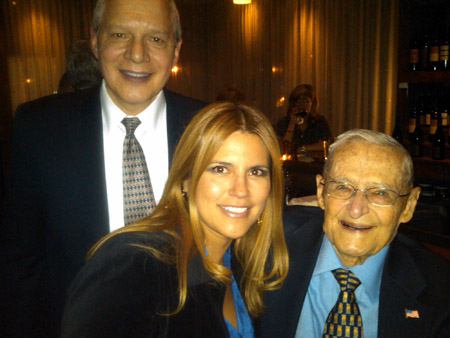Secret Agent Man
I woke on the farm this morning. I slept on the couch in the great room, listening to the mournful sound of the freight trains sounding their whistles at the grade crossings over by the hamlet of Winston. I thought of my Irish ancestors at work on that very track, heading south and west to Nashville, where they took up residence prior to the Late Unpleasantness Between the States.
I have a meeting in Charlottesville with a new Government customer, and coming south under blue skies of a late-January seemed to make a lot of sense. I don’t want jinx anything on this la Nina-influenced winter, but we may have dodged the worst that the season can throw at us- four weeks more in the Short Month and the azaleas will be poking up.
No cat, sad to say, though she may show up on patrol in the morning. I will refresh the food in the bowl down by the garage, which has been consumed by some critter or another.
The deer are back after the hunting season has closed, venturing out of the deeper scraggly woods and back onto my pastures. The droning of a small private plane miles away and the barking of a dog in the middle distance were the only sounds, save those of the rustling branches in a fitful breeze.
I had an hour or so of productive time after I bustled around, and could have hung a new thermometer on the deck, or got to some of the chores that have a timeless quality. Then I thought about reading a book- and actual paper-printed book- and listening to satellite radio.
Easy choice on that score. I have a Scandinavian blood-soaked detective story in progress, and a strange surreal account of life in a small-town in North Dakota called “Down Town Owl” by Chuck Closterman. I hefted them both and with a sigh, decided on a third.
An old shipmate from Texas had his publisher send me a copy of his latest book, a tome about the life and times of a Confederate naval acquisition specialist. I had thought about buying a copy, although I gulped at the price. They want $55 for the lengthy trade paperback, which is what I pay for the folio editions of the great books that I use as decorator items. This self-publishing business is a hard one, and I felt a certain obligation to support other non-mainstream authors. I was going to get to that, when a hefty manila envelope arrived in the Saturday snail-mail.
It was a free copy of Texas Walt’s book, sent to me in my capacity as editor of the little professional Quarterly, and for the purposes of generating a favorable review. I could put it in the pile of things to do in the flurry before press time, but I have learned to just touch things once, get it out of the way and move on.
I sat on the couch with the rich sunlight lowering across the front porch and making last fall’s ornamental grasses stand in bold gold. Then I starting reading about Richmond’s Secret Agent Man in old Europe, the procurer of gunboats and commerce raiders and blockade runners who drove Mr. Lincoln’s admirals nuts.
If this were a review, which it is not, per se, I would start it like this:
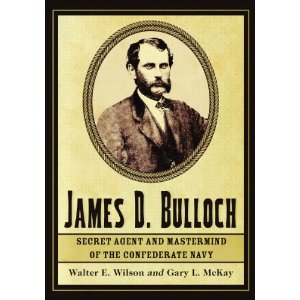
James D. Bulloch: Secret Agent and Mastermind of the Confederate Navy
Paperback: 368 pages/$55
Publisher: McFarland (January 20, 2012)
ISBN-10: 0786466596
ISBN-13: 978-0786466597 (ebook)
Orders: www.mcfarlandpub.com <http://www.mcfarlandpub.com> or toll-free at 800-253-2187
I would have noted that the Gazette was proud to note the issuance of the first biography of James D. Bulloch, agent extraordinaire of the Confederate Navy who operated a vast network of procurement, intelligence collection and privateering from Europe throughout the American Civil War. Bulloch was an ingenious secret agent who conjured up a fleet of cruisers and blockade-runners from his base in Liverpool against incredible odds and under enormous pressure by the Lincoln government in Washington. Prior to the war, Bulloch was an extraordinary US naval officer and commercial sea captain. The book details Bulloch’s exploits and his impact on American history, and that of the larger world stage.
This is a most entertaining account of a sadly neglected aspect of the industrial age global war. In addition to all that, Bulloch survived the war, remaining in exile in Liverpool, but remaining life-long friends with Theodore Roosevelt, Sr., and was the favorite Uncle and mentor of a future U.S. President, Teddy Roosevelt. There is also a tantalizing possibility that Bulloch and his family provided the inspiration for the young Margaret Mitchell’s “Gone with the Wind.”
As the former head of the Navy’s intelligence operations in Europe, Walt Wilson felt a special connection with Bulloch, and writes evocatively of the world of espionage that made the American Civil War a global enterprise. Blockade-runners and commerce raiders were Bullock’s stock in trade, that and the collection of intelligence from a network of Rebel agents across the continent.
In large measure, Bulloch’s accomplishments were overshadowed by the exploits of the ships he acquired and launched on the world ocean to prey on Union merchantmen and the whaling fleet.
“James D. Bulloch: Secret Agent” is the second in a trilogy of books about three important Confederate naval commanders that have been overlooked for far too long.

The first book, “The Sea King: The Life of James Iredell Waddell” (Birlinn, 2009) detailed the life of the man who commanded the famed commerce raider CSS Shenandoah, the only American Civil War vessel to circumnavigate the globe.
Using the ship that Bulloch had procured for him, Waddell singlehandedly destroyed the US whaling fleet and almost brought the British Empire into the war on the side of the South. Waddell was a thorn in the side of the Johnson Administration (the first one) in the immediate post-war period in which Waddell remained in command and at large. He finally surrendered to the Royal Navy after a 22,000-mile journey to Liverpool. Proclaimed an American hero upon his death in 1886 he was given the only state funeral ever awarded for a former Confederate office.
Second in the series, Bulloch’s biography is a joint effort between shipmate Walt Wilson and Gary L. McKay about the most mysterious naval official on either side of the American Civil War.
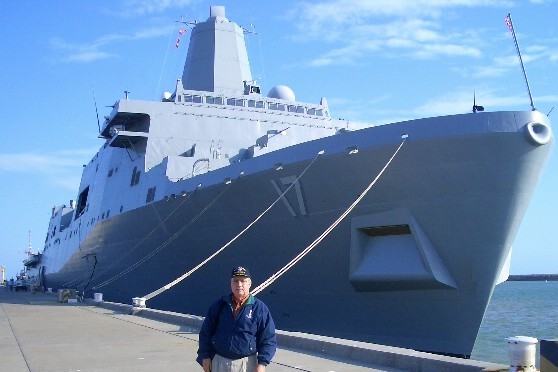
(“Texas Walt” Wilson strikes a pose before USS San Antonio (LPD-17) lead ship of her class of amphibious transport docks. She is the first ship named for the city of San Antonio, TX.)
Gary L. McKay is the co-author, and is a “lead researcher at Float Research UK, a dedicated geo-spatial engineering firm specializing in remote sensing and digital cartography.” He had 17 years experience in the US Navy and US Army within the electronic intelligence, intelligence analysis and counterintelligence communities, so his chops are good.
He claims his next project is a secret, but I am betting it might be about Raphael Semmes, Confederate Admiral and skipper of the deadly raider CSS Alabama.
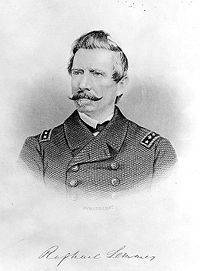
(CSA Rear Admiral Raphael Semmes, Captain of the Alabama, who took his war with the Union to the world ocean.His epic losing engagement with USS Kearsarge off the French coast electrified Europe.)
I won’t break the other secret, which is that of course it will be a positive review. You have to help out other authors. It is a tough world for us- I saw and article in the times in the darkness of the great room on the glowing computer screen that book giant Barnes and Nobel may be headed for the ashcan of history, along with all the other big chains.
Apparently Amazon is killing them off. I felt bad when I read the article. B. Dalton Bookseller and Crown Books are long gone. Borders collapsed last year. Now it is just B&N against the implacable Kindle and the Amazonian business model.
Shoot, that is how I get my reading stuff these days, except for the fancy editions that mostly just serve as three-dimensional wallpaper in my living room.
To get his book on the street, Texas Walt’s publisher has to ask for $55 a copy. This is a hard world, isn’t it?
I would have bought it, really I would. But I would probably have bought it from Amazon.
Copyright 2012 Vic Socotra
www.vicsocotra.com
Coming Home
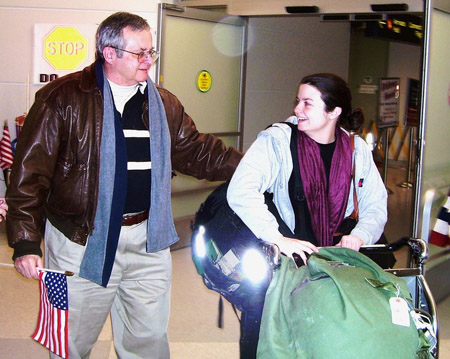
Changing of the Watch. An old shipmate greets his daughter, home from war. Photo Mazzafro 2012 rights reserved.
Bobbie got back on Thursday. She had gone to see the elephant. She arrived happy and in good shape, according to my pal Joe, who was beaming with relief and paternal pride. His little girl was out of the war zone.
She had been part of the surge of troops intended to knock the Taliban back on their heels, disrupt their sanctuaries and set the stage for withdrawal of the International Security and Assistance Forces from Afghanistan.
The long grinding conflict in Iraq is mostly over for us and those of our children who were exposed to that adventure in global power projection and its uncertain resolution. The surge in Afghanistan is being drawn down, even if there are unsettling developments.
France suspended its training operations and will withdraw its entire force from the country early, in the wake of another attack by an Afghan government solider against ISAF personnel.
In this one- the second in a month- came during a particularly deadly day for the international military coalition. Six U.S. Marines also died in a helicopter crash the afternoon Bobbie got back. Even apart from direct contact with the Taliban, war is a complex and perilous business.
Although 30,000 US troops are scheduled to be withdrawn, 70,000 will remain in the country through this new year and the next. Even as all US combat troops depart (as they are scheduled to do by the end of 2014) a core of trainers and other personnel (including the Spooks, of course) will remain.
So it is with a great deal of relief that Bobbie’s folks and uncle Pete went out to greet her at Baltimore-Washington International. To my pal’s surprise, Bobbie and the other returnees were also greeted by members of Operation Homecoming. In addition to some older vets, there was a small task force of young people from the Girl Scouts, 4H, and local schools to cheer and welcome home the returnees.
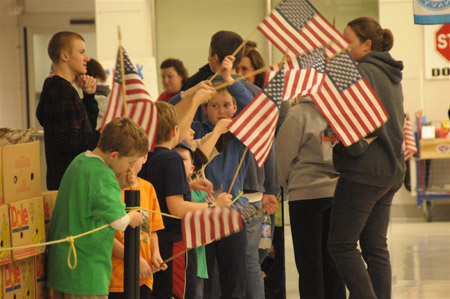
The kids of Operation Homecoming. Photo Palmtree37.
The Homecoming people monitor the flights coming back from the zones of conflict, and arrange to have people there to greet the troops. Since March, 2007, volunteers have greeted more than 60,000 returning men and women. They hand out care packages to tide the kids over, since unlike Bobbie, most are going to camp out at the airport waiting on flights to get home. This is a big country, and those who went to war are widely scattered in the vast population they protect.
“I was very impressed with the civic lesson that was going here,” he told me. “Young people learning to appreciate the service of others for national security and those who have been engaged in defending our nation seeing visibly that what they have been doing is not only important, but appreciated by young people who will be the long term beneficiaries of the security they have been providing.”
That is quite a change from the greetings that some of my peers got when they debarked from the Pan Am charter flights out of Southeast Asia, and it is gratifying.
Bobbie is home. My pal out west reports that his daughter Kate is on a series of jets coming back from a six-month deployment around the globe on behalf of an agency located not far from BWI. My pal Muhammmed’s son is forward deployed, and has his nuclear family on the ramparts in the Balkans. His wife is serving as well. My guys are herein safety, for now, but the clouds rising over China may have them off to the broad swells of the western Pacific sooner than any of us know.
I just thought I would give a shout out to Operation Homecoming, and Bobbie, James, Nick, Eric, Paige and Kate and the thousands of others who have parents that sweat each phone-call while they are gone. The watch has been changed. These men and women represent the best that is in us, and a demonstration of commitment and courage that inspires me.
Bless the troops. And bless those who turn out to welcome them home.
If you happen to be in the DELMARVA area, you might want to drop by BWI sometime. If you do, call the Operation Welcome Home hotline before heading to the airport, to make sure the flight is still scheduled to land. Charter flights have their vagaries, though those who travel that way generally don’t mind so much if the airplane is headed home. The Operation Homecoming hotline number is 410-630-1555. http://www.operationwelcomehomemd.org/about/
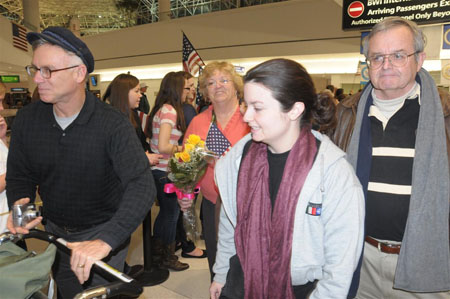
You can see the relief in the faces of Uncle, Mom and Dad. Photo from Palmtree37 of Operation Homecoming.
Copyright 2012 Vic Socotra
Photo credits Mazzafro and Palmtree37.
www.vicsocotra.com
Kate’s Cupcakes

(Stacey with an e holding one of Kate’s famous red-velvet cupcakes with butter frosting. Photo Socotra.)
I am about done with the hot-button topics of the week. It is Friday, after all, and thank God for that. I was thinking, something I normally do right after mashing the “send” button on the story that the difference between Ike, love him or don’t, and the rest of our recent Presidents is that he is the one who was not a politician.
Not that you get five stars in the Army without being adroit at fun and games in a massive bureaucracy, but you know what I mean. Look at the men who followed him:
Ike was the only career non-politician in the crowd. Truman was one, Jack Kennedy another, Lyndon the consummate one, Tricky Dick a committed one, ditto Jerry, Carter was a semi-neophyte (and it showed) and Ronnie was a corporate shill who came to his calling relatively late in life. Everyone since has been playing the game first and foremost, and maybe that is why things are so screwed up. The money required to play means that those who have, get more. By way of contrast, Ike was courted by both parties, and was a management guy of the first order. Not one inclined to rock the boat, but his response to the outrage in Little Rock was gratifying.
I also got some feedback that was along the lines of the line from True Grit: “That’s bold talk for a one-eyed fat man!” Specifically, the comments pointed out acidly that I am at the trough of Big Government and have been most of my working life. I take the point.
We are stuck with the colossal and unholy amalgamation of industry and the Armed Forces- an aggregation in which Acquisition of big-ticket systems is King and those who served are a bit of an afterthought. And there are not that many of us around, now that the Greatest Generation is passing. The military industrial complex is real and a problem. Just because I highlighted the second accurate observation about the scientific-technical elite is no criticism of the first; we just are getting jerked around by the latter as well as the former.. Technology is something that our laws and lawyer-class are having a problem with. You saw the ruling by the Supreme Court that placing a GPS tracker on a known drug-dealer’s car for a month or more was an unconstitutional violation of his rights, and his conviction on cocaine charges was thrown out.
I think that is good- I mean, the argument that if you are not doing anything wrong why would you mind only goes so far. But the Court took its own sweet time getting to this ruling, as it always does, and there are far more issues at hand than any narrowly reasoned case can address.
I saw that Boeing is about to deploy a new system on its jets that will make them impervious to hi-jacking. Apparently the pilots will have a one-way switch to transfer control of the airplane to people on the ground, and it features automatic landing algorithms. Sensors on the cockpit door would automatically engage the system and it is not possible for anyone to switch off the autopilot.
I guess this is a good thing, right? But the same article went on to describe the other component of the system- a passenger-monitoring device that will use “tiny cameras linked to specialist computers to record every twitch, blink, facial expression or suspicious movement made on board flights in order to identify potential terrorists.”
I can see this is going to make flying even more fun than it is now, and the system clearly has broad implications for all sorts of ordinary situations. Wouldn’t employers like this as a work-place tool? Any public place? Why would we mind, if we aren’t doing anything wrong, right?
I don’t know. I have often thought that the future was a place I only wanted to visit briefly. So, I walked over to Willow, the public place I like best at the moment and got a glass or two of Happy Hour White after work. Old Jim is back from a job he was doing in Maryland, and his vivacious wife Mary stopped in on the way back from the gym.
That was how, in a roundabout fashion, we became interested in what the couple next to us at the bar were up to. They were foodies, and engaged Liz-with-an-S in detailed conversation about the Nosh menu of bar food. The woman was a vegan, and opted for the barely-cooked broccoli salad while the man tucked into the fish tacos.
Jim was expressing some firm views about the deplorable state of post-secondary education when the cupcake arrived.
I have to say that it was completely magnificent, a thing of wonder. The butter-cream icing was improbably high, neatly decorated on the top, and the red-velvet cake below sinfully inviting.
I asked if I could take a picture of Kate Jansen’s example of master baking, and the woman- who turned out to be Stacey-with-an-E- agreed. She spent ten minutes after the shot disassembling the thing.
Jim looked over his Bud. I looked over the white wine. Any world that has Kate’s cupcakes in them isn’t lost yet.
I hope.
Copyright 2012 Vic Socotra www.vicsocotra.com
I like Ike
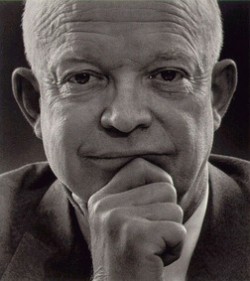
Socotra House is a concern without specific ideological agendas.
Oh, hell, that is nonsense. Sorry. I know when we start out on these little soap-bubble voyages that we are going to wind up taking a shot at people and things, but I assure you there is actually a vague attempt at a balanced (if jaundiced) view of the Continuing Crisis. I established an office to do it, with a desk and a workstation, but I have not succeeded in finding an ideologically pure candidate to sit in it.
I knew I would irritate some of my best and smartest readers, who consider The Daily a semi-entertaining vehicle of diversion except when it wanders into politics or the climate.
Recognizing those sensibilities, I try to avoid the more truculent approach to obvious public displays of lunacy. Of course, with a Presidential campaign in progress, and such mendacity being displayed by all who consider themselves egotistical and well-heeled enough to actually want to be in the Oval Office. Either of those traits suggests problems of mental health or corruption, but you pays your money and takes your chance, I guess.
Anyway, It wasn?t always like that, or at least there were periods in which venality and pandering were not the norm. In an exchange yesterday, I remembered that the first two public events I recall in this world were the Soviet invasion of Hungary and the heart attack of Dwight Eisenhower.
Ike had a left anterior myocardial infarction in September 1955, while on vacation at his in-laws’ house in Denver. It was widely reported in the media, and it filled this little boy with unease. I mean, if avuncular old Ike could be struck down, what of everything else? I see no direct connection with the crisis in Hungary the next year, but it was another of those pivot points that determined how a good chunk of Europe was going to be run for the next thirty years- and by the end of which the little boy would be an aging bureaucrat and apparatchik.
I also remember eating dirt with Tim Veryzer in the backyard of the rental house on Kentucky Street in Detroit, but that was not so widely reported in the national media and I cannot Google up a year for the occasion.
It is interesting to look back at what happened in Hungary- it was late in 1956 and I was in kindergarten. A student demonstration in Buda-Pest went viral in October, and continued into the beginning of November. Thousands of other citizens thronged to the city to support them, and there were martyrs manufactured by the Security Forces- the AVH- who shot down demonstrators who attempted to occupy the studios of Radio Hungary.
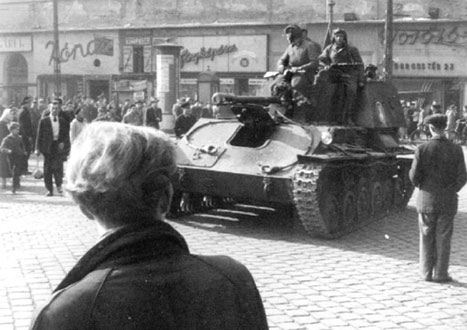
The revolt spread with the speed of news across the country, and the government collapsed. So far, it sounds a little like what is happening in our world. But as popular militias stood up and pro-Soviet officials were detained or executed spontaneously.
The replacement government was not like the one in Epypt, whose anniversary of Mabarak-free rule was uneasily observed by the Generals who served him and the people who let him go.
The Hungarians disbanded the ÁVH and announced they would be pulling out of the Warsaw Pact. The Kremlin was disconcerted, and initially agreed to start negotiations to withdraw the Red Army. Instead, the Politiburo deliberated, and then decided to crush the revolution.
Hungarian resistance continued until 10 November, and there were those who called for Ike to intervene, a course of action he eschewed. I like a lot of things about Mr. Eisenhower. As a soldier who had actually borne the hardship of war, he was reluctant to enter in to it lightly, unlike some of our subsequent leaders.
The Iron Curtain was a new reality, and America and NATO girded their loins to deal with it. I don?t remember much after that in the 1950s, until that young good-looking rake JFK decided he had the looks and the money to be President.
There is way too much to remember about the 1960s, and I am not going to try this morning.
Instead, reading about Nobel Laureate Al Gore?s impending visit to document the ice-melt in the Antarctic, and the mysterious alteration of the historical temperatures of Reykjavik, I remembered the second warning contained in Ike?s last address from the Oval Office.
Did I mention that Mr. Gore is going to go looking for melt in the Antarctic summer? Never mind.
We had a consensus back in Ike?s time that a robust military was necessary to oppose the implacable Communists. Funny that I have come to miss them a bit.
But Ike was a man of impressive observation, and he saw something else that had come to America with the urgency of the big war. We see it all over these days, but it is not talked about as much as the threat from the military-industrial complex.
I was talking to my pal, West Coast Guy. He is one of the most thoughtful of my associates, and is confident that man-made greenhouse gases are going to cook us alive in our own gravy. I respect his views on the subject, but differ on the matter of whether the science is settled.
I had to write him back, saying that key judgment and take ?away from the discussion is whether or not there is a tipping point in the concentration of gases, and if there is, whether we have reached it.
The Scientific Community that has congealed around the climate issue is resolute that something really important is going on and action must be taken.
That is by no means a universal opinion, although contrary views are usually attributed to the influence of Big Oil and the usual exploitive and manipulative capitalists. The Scientific Consensus, of course, was in turn largely funded by Big Government, so I contend that this is at least as much a political and public policy argument as it is about the weather, which isn?t climate.
In my lackadaisical pursuit of the topic, I have seen that some paleo-climatological folks are saying that we might even have the cause and effect of the atmospheric CO2 concentration backwards.
Dunno. I am no scientist. We agreed to shrug and say “oh well,” though he will continue to be pro-active and do the right thing as he sees it. But it got me to thinking about the other thing that Dwight warned us about in his last best speech by the last best guy to serve in the White House:
“We must never let the weight of this combination endanger our liberties or democratic processes. We should take nothing for granted. Only an alert and knowledgeable citizenry can compel the proper meshing of the huge industrial and military machinery of defense with our peaceful methods and goals, so that security and liberty may prosper together.”
The President then went on to describe something else that deeply troubled him:
“Today, the solitary inventor, tinkering in his shop, has been overshadowed by task forces of scientists in laboratories and testing fields. In the same fashion, the free university, historically the fountainhead of free ideas and scientific discovery, has experienced a revolution in the conduct of research. Partly because of the huge costs involved, a government contract becomes virtually a substitute for intellectual curiosity. For every old blackboard there are now hundreds of new electronic computers.”
“The prospect of domination of the nation’s scholars by Federal employment, project allocations, and the power of money is ever present and is gravely to be regarded.?
?Yet, in holding scientific research and discovery in respect, as we should, we must also be alert to the equal and opposite danger that public policy could itself become the captive of a scientific-technological elite.”
We are there. I eagerly await Mr. Gore?s report from the South Pole.
Copyright 2012 Vic Socotra
www.vicsocotra.com
The State of the Onion

Socotra onions, Videlia, two each, in the ready-locker at case Socotra. Photo Socotra.)
I tried to watch the State of the Onion thing on the tube last night but got bored after the first half hour of celebrity blather. I toddled off to bed before we got to the class warfare thing. Apparently will be the basis of the campaign this year.
I surrender. As Michelle has observed in the new book “The Obamas,” the President is way too smart for us to appreciate and we are letting him down.
I will try to do better.
That said, I did not see any specifics in the address in which I was interested, since I already pay more taxes as a percentage of income than he wants Mitt and Warren to pay, and of course the real nut of the matter is that fewer and fewer people are paying for more and more people with their hands out.
It is not new, and they could have run the speech from last year. Along the way, they lost me with that ?millionaires and billionaires earning more than $250K a year.? Remember that one? That seemed like the opening salvo in lunatic rhetoric, matching the insanity from the right that taxes can never ever be raised for anything.
Neatly segued into the informed commentary about how decisive the President was is a gleeful media chorus about the Mittster?s 13.9% tax rate.
Remember, the guy is unemployed. And he did pay taxes. Any way you cut it, paying $3,000,000 in capital gains trumps whatever it is that Warren Buffett?s secretary contributes, regardless of the percentage.
I would go on with the tirade, but I am an equal opportunity skeptic, and after all it was the President?s turn to trot out the nonsensical last night, rather than the loons on the right, and it only seems fair to express the resentment that a lot of folks feel about not having anything to actually choose from.
The amount of money we are spending- by the way, it has been a thousand days since we actually had a President?s Budget in this country- is unsustainable.
That means what we are doing cannot be continued and we have to figure out something else.
The alleged blueprint from last night?s speech isn?t going to cut it any more than the Tea Party alternatives.
We have saddled ourselves with a tax code that is incomprehensible, passed in a bipartisan manner by the criminal class that occupies Congress, and abetted by whoever happened to be occupying the Oval Office at the moment.
So, if we want to have a discussion about Capital Gains, we ought to do that. If we want to talk about the progressive tax structure that has idiots like me who make a paycheck paying 33% to Uncle Sugar, fine. Let?s do that.
But instead we are going to get hallucinogenic nonsense. It makes me cranky.
So, why don?t we talk about something optimistic. Like death.
I have spent the last two days slogging through the layers of onion that the gatekeepers at the broker?s office are inventing ways to keep me out of Mom’s account so we can pay for her passing.
As part of the full-employment-for-lawyers aspect of death, I have had to enlist an attorney to register our official dissatisfaction with the process.
I need to set up a trust of my own and get things squared away, arrange for burial issues and that sort of stuff. My experience has been that life is too busy to pay much attention to things until it is way too late. I have the folks in my library on a middle shelf, with my unit number in black magic marker on the exposed sides of the USPS shipping boxes.
That seems to be the logical thing to do. I had signed up for an actual in-ground burial at Arlington with my friends at Murphy’s Funeral Parlor, but on the whole, I think I made a mistake and will opt for flash-fry.
At the time, I wanted to avoid the Columbarium, but the last funeral I attended there was just fine, and frankly I have no idea what I was thinking. They tell me you can request in-ground placement of the cremains, too, so what the hell.
Just one of the long list of things to be taken care of- that and starting to lean down the crap in the apartment- make transition issues that much easier. There are so many rabbit holes to dive down in closing up the affairs of people who lived to be almost ninety.
I doubt if I am going to get that far, and I am perfectly fine with that. My Mom’s passing was so magical that I hope that is in the genetic code, too. Only two things in life are certain.
Mom peeled her onion just fine.
Copyright 2012 Vic Socotra
Fire From Above

M9-class solar flare erupting on the Sun's northeastern hemisphere Jan. 23, 2012. NASA/SDO and the AIA Consortium/Edited by J. Major
The strongest radiation storm since 2005 is raging on the sun. You know things have been ominously quiet up there, but that is over.
NASA’s Solar Dynamics Observatory recorded a monster ultraviolet plume on Sunday, a colossal jet of “coronal mass ejection” from sunspot 1402. The charged particles will strike the earth this morning, and I cannot tell you if it will affect the State of the Union address by the President tonight.
These things can, of course, and the solar impact on the weather and the climate is one of those things that is imperfectly understood. They are re-routing airline flights and turning satellites so that their more shielded sides are facing the blast.
I am hoping that we keep the global positioning system and other space-borne conveniences of modern life. Everything seems to be up in the air these days, and with the State of the Union Address tonight, I am expecting the themes that will plague us until election day this November will be trotted out and given a trial run.
I don’t think they are going to turn on the television at Willow, but naturally I am interested in how the message is going to be spun for consumption by the lumpen electorate.
Naturally, the blast won’t mimic the majestic plume of ejectorate of the solar flare. Our political classes specialize only in emitting heated oxygen and C02, both of which are normally harmless, but can have a greenhouse effect all their own.
Mitt and Newt are demonstrating that big time down in Florida. Mr. Gingrich and Mr. Romney are savaging themselves to the point that both are wounded, and perhaps fatally. I have always thought the former Speaker was basically unelectable, an Mr. Romney may be too patrician to campaign well in the general election.
The whole mess about the taxes is a case in point. Mitt apparently posted his taxes for 2009-10, and from what the media is telling us this morning, he coughed up $3 million each year to the IRS, and $7 million to charities, which strikes me as a lot.
The commentators hasten to remind us that even though his check to the government had a lot of zeros in it, the percentage amounted only to the 15% of the capital gains rate. Since he did not have a paycheck, per se, he falls into the Warren Buffett category of taxpayers who really want to pay more but can’t get around to it unless everyone else does, too.
I can’t dredge up either a lot of enthusiasm for Mr. Romney’s careful adherence to the law, nor a lot of envy about the fact that he can get away with it. I am confident that the President will seek the most advantageous rate for his own filings once this ceases to be a litmus test on privilege- everyone, including Mr. Buffett, do the same thing.
Oh, did I mention that Warren’s Burlington Northern Santa Fe LLC railroad is among the U.S. and Canadian firms that stand to benefit from the Administration’s principled decision rejection of the Keystone XL pipeline permit?
I am not wasting a lot of time worrying about it. There is too much going on here trying to do estate paperwork and parse files, the oldest of which was done on Mom’s Smith-Corona in 1962. If you want to have fun on the internet, try to track an insurance company down through the years that has changed names more frequently than Newt’s wives. It is strange that the people of South Carolina gave him a pass on that. I am going to vote in the Virginia primary, I think, because all you have to do is show up and claim you are one.
Someone sent me a quiz the other day sort of like the ones in Cosmopolitan about finding your g-spot, and about as relevant. It was designed to show where you actually are on the political spectrum. There were five questions on social issues, and five on national economic policy. Having answered with the usual ambiguity, I discovered that I was mostly with the Centrist-Libertarian-Left side of the distribution, by which I favor same-sex marriage for those who like it, legalization of some things, and reinstatement of some sort of national service, feel a slid “maybe” on government bail-outs and strong on national defense.
There isn’t anyone who wants any of those things running at the moment, so I intend to withhold any decisions. There is going to be so much time to listen to what the campaigns have raised so much money to spend on telling us.
This is a centrist nation at its heart, and the desperate play to the base of both parties- pandering to the ridiculous- is demeaning to democracy but that it what it is, here is the somewhat threadbare Greatest Republic on Earth.
There is one thing, though.
It turns out that Mitt and I share something more than having a father who worked for the other one in Detroit.
I graduated from college in 1973- the pivot point on when the great city of Detroit pivoted between Law and Order politics on the right, and Big Government on the left.
I had secured, much to my surprise, a living wage from the McGraw-Hill Book Company to travel to an assortment of higher education concerns in Southeastern Michigan, and had intended to stay right there in Looney-tunes Ann Arbor. Management was smarter than I was. When they asked about the location from which I would be working, they specifically told me that hanging around with my college buddies was out of the question.
I wasn’t exactly broke, but close enough to it, and the folks were eager to see me off the family payroll. I started to look around, and saw an opportunity that did not come with a lease or damage deposit.
My pal George’s folks had bucked the trend in mass urban flight after the riots, and traded the ranch-style house in Bloomfield Hills for a mansion on Afton Street in the Palmer Woods neighborhood of NW Detroit, not far from the border at Eight Mile. just after the riots, entranced with the private security in the development and the posh luxury of the stately manor, originally chartered by the fabled Burton Abstract and Title family.

19440 Afton St., Detroit, Michigan. Nice place. Mitt and I lived above the garage. Photo Socotra
I did not know until this week that the house had another owner along the way- George and Lenore Romney. I am confident that the kids used all the available bedrooms, and I may have had my quarters above the three-car garage in the same room as Mitt.
Nice house. But of course the Romney’s had plenty of dough, and got out of Detroit while the getting was good.
Oh, Detroit runs out of cash in March and may go into State-controlled receivership. The local activist groups are incensed at the abrogation of local sovereignty, though of course, this is a completely self-inflicted wound, courtesy of the late Mayor-for-Life Coleman Young and finished off by the self-aggrandizing swindler Kwame Kilpatrick.
Too bad. It was a great city in its day. I am deliberately not going to extend the metaphor to anything else in particular. I have to get in the shower and be ready for the solar flare.
Copyright 2012
Vic Socotra
www.vicsocotra.com
Under the Rising Sun

Gentle Readers,
We screwed up here at The Daily yesterday. Not unusual, as I am sure you will attest, but I got caught this time by two senior intelligence officials and I need to explain. Typing quickly, I noted that the ship from which my pal Mac acquired the “small” battle flag- the mighty IJN BATTLESHIP Nagato, was a heavy cruiser. No, no, no.
I feel bad, and hence, this morning’s outing will be a “letter to the editor” from a distinguished (and still serving) government official.
“Vic: Ref your discussion with Admiral Mac about the battle flag of the Nagato, I have to correct you on a small error. The IJN Nagato was a battleship, not a battlecruiser (she displaced 42,850 tons with her full wartime full load and mounted 16 inch guns). Admiral Isoruko Yamato issued his famous order of December 2, 1941, to launch the attack on Pearl Harbor from the Nagato, then his flagship. A 16-inch shell acquired from Nagato (and/or its sister ship, Mutsu) and modified for aerial bombing, was credited with sinking the battleship USS Arizona.”
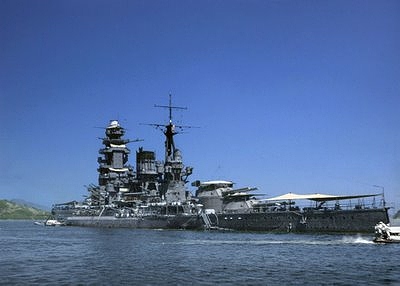
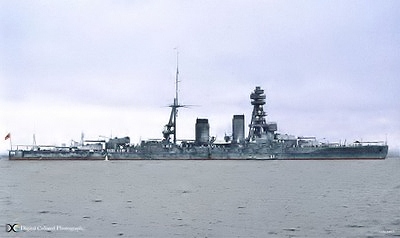
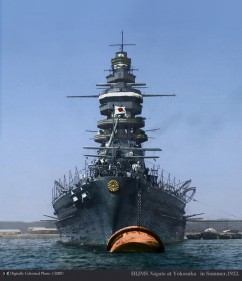
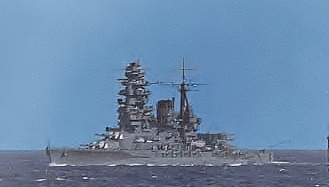
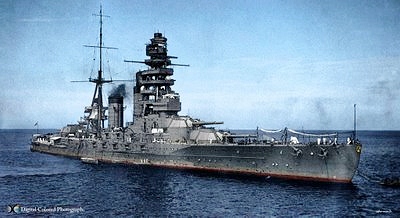
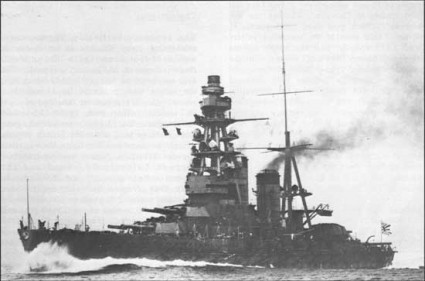
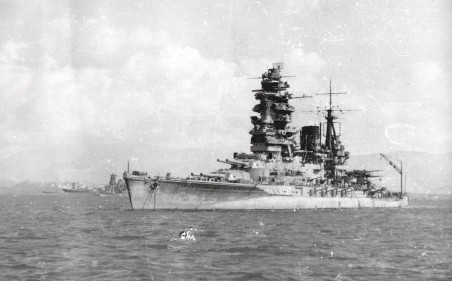
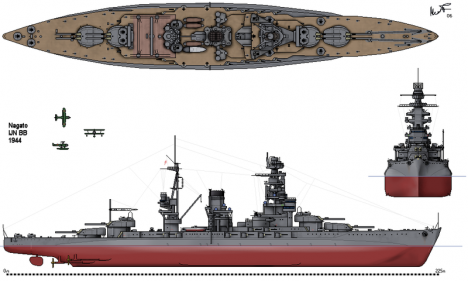
As you know, this vessel met its end at Bikini Atoll, as a result of damage sustained during Test Baker, Operations Crossroads on July 26, 1946. My buddy Art’s participated in that test as a civilian scientist and member of the Manhattan Project’s Radiological Safety and Survey Team. One of his tasks was to instrument the target ships prior to the test and he boarded the Nagato, climbed the Pagoda mast, and went all throughout the ship’s spaces. Nagato underway in the 1920’s:
The Nagato October 1944:
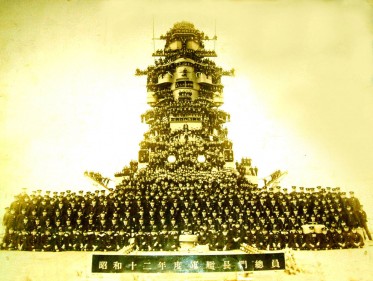
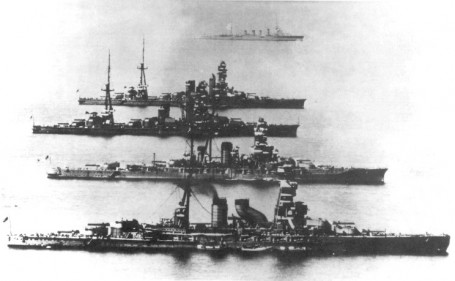
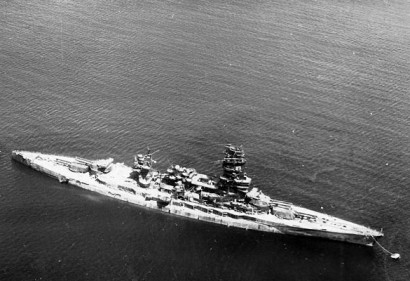
In the photo above, starting from the top, are the Nagato, Kirishima, Ise, and Hyuga (the latter two converted into battleship/aircraft carriers after the Battle of Midway). Here she is at anchor in Yokosuka in 1945:
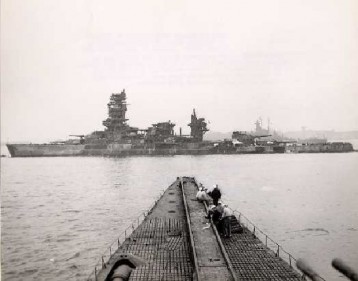
Shown below is how the once-proud Nagato looked before the test in 1946:
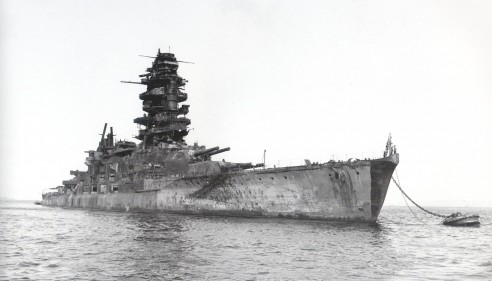
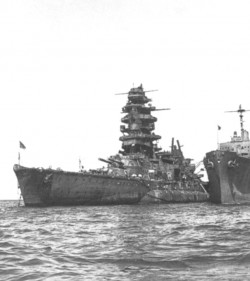
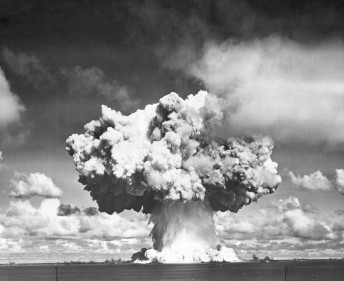
You can just make out the Nagato out in this photo taken from the shore, silhouetted against the lower left of the base surge. (Note: the image below is reversed from the one above). Noel Gaylor was the commander of the overall operation, an account of which was told in the Admiral’s obituary we published not long ago.
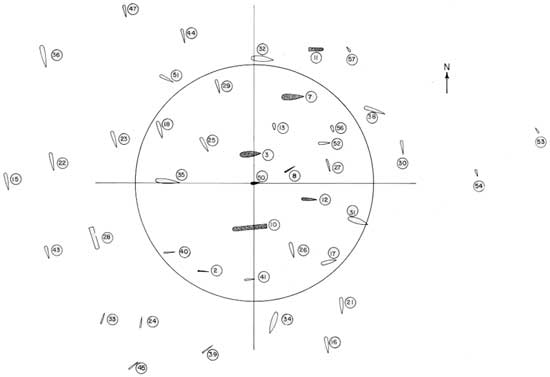
The chart above shows the position of the Nagato in the test relative to the actual position of the point of detonation from the submerged device (#7 in the upper right quadrant — USS Arkansas, #3, moored within 500 feet of the detonation point, reportedly sank within 19 seconds). Nagato was heavily damaged by the Test Baker shot – the external paint burned, the upper works broken and twisted, armor decks were bent, and seams were opened in her hull by the shock wave (the initial surge reportedly moved her 400 yards). She slowly filled, capsized and sank in the lagoon, 29 July 1946.” See: “The Final Voyage of the HIJMS Nagato Battleship” for some interesting details on the poor condition of the ship after the war and challenging voyage to the test area: http://www.bikiniatoll.com/nagatolog.html
I wrote my pal back: saying “I have a manuscript copy of an account by Edward Smith Gilfillen, Jr., who was a member of the Intelligence Mission to Japan in 1946, and the XO of ex-IJN Nagato for that voyage.
The technical report of the mission is at:
http://www.scribd.com/doc/32940827/USN-Technical-Mission-to-Japan-History-of-Mission-US-1946
My Uncle Jim got the manuscript from Gillfillan’s widow, who he said in his cover memo had also provided “18 HUGE radio tubes and a big variable condenser from the NAGATO of the Antique Wireless Associations Museum.” (caps used in the original note).
Correcting the record is always problematic, but I hope you will accept my apologies for failing to think while typing, a real hard of the trade.”
Copyright 2012 Vic Socotra www.vicsocotra.com
Waking Up a Winner
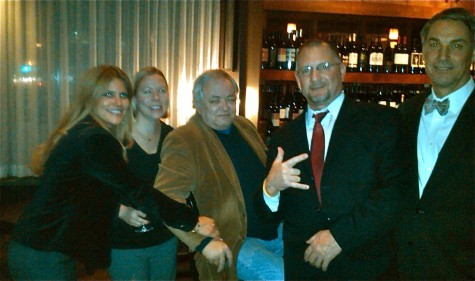
The Amen Corner in full swing. Left to right, The Lovely Bea, beautiful Jamie, Old Jim, Short Hait Mike and Jon Without on 12 January 2012. Photo Socotra.
So, the Speaker trounced Mr. Romney down in South Carolina, and the circus appears set to continue into the slightly less dark month of February. I don’t know what is next. I suppose I should go and check. I used to see the Speaker around town, the last time on the sixth deck of the Original headquarters Building at Langley where apparently he was dispensing wisdom.
I was thinking about that, and the fact that any morning I wake up, I consider myself a winner. Our pal Mac has seen these election carnivals down through the years, actually serving Franklin Delano Roosevelt and all the rest through Ronald Reagan. I should have asked him the last time I saw him at Willow about the first President he could remember being in office. I doubt if he can remember Warren Harding and his less-than-star turn in the Oval Office, but you never can tell.
I will write down the question and hope it helps me remember for our next session. He can certainly remember when the banks closed and there was no cash money in the big cities of Iowa, and people had to get by with a barter economy.
I looked at the stack of cocktail napkins by the computer. Time to finish transcribing the ink on them before I put the coffee cup on them and the history is lost in smears of brown-and-blue stains.
So, just to being you up to speed, the gang is out in force at Willow. Old Jim is entertaining at the Amen Corner; John’s With-and-Without are holding court; Short-Hair Mike and his beautiful associate Jamie were down the bar, and cycling back and forth. West Coast Guy was in town, and things are rocking in the extended-hours of Restaurant Week.
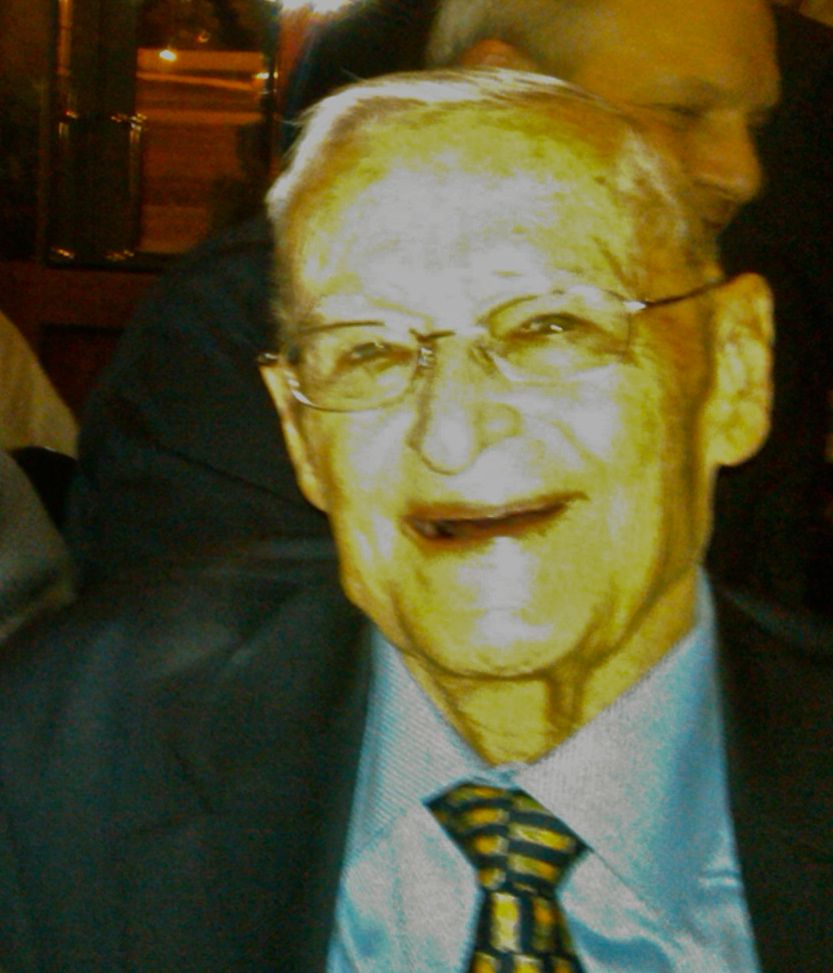
Mac is dressed to the nines, and I am in my usual goofy bow-tie and vacuous look. I am trying to understand how things felt in 1945, after the war ends, and the strange period of sudden peace that followed the most titanic struggle in armed conflict.
“So,” Mac continued, “Sam Frankle was sent out to be the Fleet Intelligence officer- Colonel Twitty had been JICPOC- he got promoted to Brigadier while he was there- but he desperately wanted to be back where the action was. In 1946 that was the Central Intelligence Group- the C.I.G.- which was in the State Department. Actually, it was on Hospital Hill across the street from the Main State building at Foggy Bottom.
“That was the happening place at the time,” I marveled. “What was it like at Makalapa Crater with the war suddenly over?”
“It was great. I stayed at the Junior BOQ- it was where the Chapel is now. There was a mess where you could have all the food you wanted, fresh vegetables and everything.”
“You only had K-Rations on Guam, right?”
“Yes, and it was horrible. To this day I can’t stomach the idea of the Pear Pie they made out of the crackers and tinned fruit.” Mac shivered at the memory. “That and the Spam that they cut to look like pork chops and breaded before frying. That is why we went to the Air Corps side to watch the bombers take off. The Air Corps had fresh milk. That was something.”
“What then?” I asked. “What was the Fleet doing?”
“Not much intelligence work, I am afraid. There were no staff conferences like during war. Admiral John Towers came in behind Fleet Admiral Nimitz, who was going off to be the Chief. I was the OIC for the change of command, which happened down at the foot of the crater on an aircraft carrier we moved there for the occasion. We had an inclement weather plan to hold the ceremony in the hangar bay, and it was a good thing, since of course it rained.”
“If you were the acting Fleet Intelligence Officer, wasn’t that a lot of responsibility for a Lieutenant?”
“No, not so much. For most of the War, Eddie Layton just had his deputy, LCDR Hudson. They did get a 24 hour watch set up though, but it was just four or five communications guys to cover messages and operate the SIGTOP.”
“Boy, is that a change form a Navy that has more Admirals than ships. What was SIGOP?” I asked. “A secure teletype?”
“Basically,” he said, taking a sip of Racer 5 Lager. “It was a machine that cut a punch-tape in plain language that you ran to produce an enciphered version.”
“Sounds like the tapes we used to cut at FOSIC Pac,” I said. “A secure teletype I forget what the nomenclature was. KG-86?”.
“Don’t know,” said Mac. “But I was the one who could type, and so I used it most of the time. You will be interested to know that the technology never went out of date.”
“How do you mean,” I said, scribbling frantically. “The incoming messages were processed exactly the way they were on the Moscow Hot Line. We were hooked up to the ECM, the local intercept station. The operators of the Radio Analysis Group Forward were known as RAGFOR. They copied mostly air intelligence information. I hang the cypher wheels and setting. I think there were two books of settings, if I recall properly, and connected Estimated, JICPOA and FRUPAC.
We were apparently on Guam again, and I made an “up arrow” next to the notes to signify that it would have to go someplace else. “You had a wine mess on Guam, right? They did not expect you to stay sober like they did in Iraq under General Order #1.”
“Of yes, completely true. When they sent me to Yokosuka just after the surrender, I took a couple bottles of Three Feathers whiskey to take to our intelligence officer forwad, but I could not find him.”
“The whiskey is what you traded that young Marine for the main battle flag of the IJN heavy cruiser Nagato, right?”
“Yep. I took the small one, but he had four, two big and two small, and I bet I could have got all of them for that bottle of liquor.”
“That is the one that you donated to the Office of Naval Intelligence to display outside the auditorium at Suitland, right?” Mac nodded. “If that is one of the small ones, the big ones must have been huge,” I said with a note of wonder.
“Probably right, but remember, there was a time when seeing a flag at a distance was important.”
“Like the ones at the car dealerships here,” I said, writing. Then we talked about his oncologist and what an increasing PSA score might mean, and the ways of medicine. The lovely Bea came over and gave Mac a hug, and we veered around again to Pearl Harbor and 1946.
“Well, by that time Bill Post was in the seat, and we cooked up a set of temporary alternate duty (TAD) orders to get me back to Washington. We didn’t hear much out in Honolulu, and I wanted to see what might be happening in Navy, and what opportunities there might be. I had the idea I might stay in the Navy, since the biggest promotions list in the history of the service was coming up, and I thought I might make Lieutenant Commander.”
“That was the trip where you saw Admiral Forrest Sherman in the passageway at Main Navy, right?”
Mac nodded. “Yes. The point was to walk around to all the offices and see what was up. Remember, until Admiral Sherman told me to apply for the Board that was going to select new intelligence officers I was still a Deck Officer.”
“Right, of course. Even though you had been doing nothing but intelligence or cryptologic work through the whole war.”
“They kept trying to send me to sea, but they never made it. Main Navy was down by the reflecting pool on the mall. The entrance was on Constitution Avenue. During the war, they added a fourth floor to all the wings of the building, and a “zero” wing on the 17th Street end of the building.”
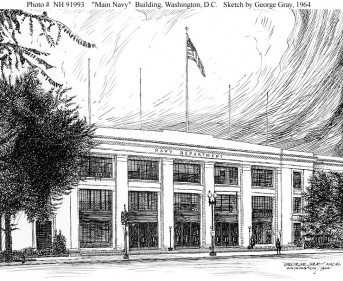
“I saw it when I was a kid, and Dad drove us down in the Rambler station wagon. Didn’t Dick Nixon order it knocked down?”
“Right you are, but it was much bigger then than it would have been when you saw it. War and Navy Buildings were erected in the rear of the main building. Temporary offices L, K, J, and I were across the reflecting pool, and there were footbridges to get across.”
“They have a picture from that era at the Army-Navy Country Club. It looks really strange.”
Mac nodded. “I had been up to talk to the Detailer at the Bureau of Navigation in the Third Wing- that is the office where BuPers was at the time- and Sherman must have been coming from the Aviation offices in the second wing.”
“Our admin assistant at BuPers was Millie Doyle. She always told us she started out at the Bureau of Navigation. The Navy had not moved to the Pentagon then, I take it.”
“No, the CNO was still in the Second Wing, and the Director of Naval Intelligence was in the 7th Wing, on the first and second decks, and BuNav was in the Third wing. Admiral Sherman must have been coming from the Aviation offices. He looked at me with those steely blue eyes. He was at all the briefings I did on Guam. During all of them I could never tell what he was thinking. Impassive guy. But that day he recognized me and called me by name. He said “We need people like you for Air Intelligence.” All the lawyers he had recruited for those jobs got out to go back to private practice as soon as they could, and Sherman had to start all over.”
“So that is when he told you to apply for Naval Intelligence?”
Mac smiled. “Yes. He told me to go down to the 7th Wing and fill out an application with Commodore Wren.”
“So the rest is history,” I said, taking a sip of white wine.
“It is all history, now,” said Mac with a smile. “Almost, anyway.”

(Elisabeth-with-an-S. Photo Socotra.)
Copyright 2012 Vic Socotra
www.vicsocotra.com
Oral History
(West Coast Guy, the Lovely Bea, and the indomitable Admiral Mac.)
“I have to drink the wine when I am out because I have to drive home,” I said. The bar was raucous for a change, people seeming to have come past the first holiday of the new year with minimal damage. The usual suspects were there, the good, the bad and, well Old Jim and I were there too.
“Any trips from here out further away from The Madison than the Willow will feature a wheelchair. Then I can drink because I won’t have to walk!” He was in a festive mood, and dressed to the nines in a suit, nice dress shirt and a boldly patterned cravat.
“I hate to plow this ground again, but until they release your oral history I have to keep trying to get it straight. What was it like when you guys got back from Guam? You had plenty of points to qualify to go back to CONUS?”
“Sure. I had been ‘forward’ since early 1942. The problem was that everyone was promised their old jobs back after demobilization.”
“That was a good thing. People would like that right now.”
“Sure they would. But remember, I went into the Service after graduating from Iowa- so I had no job to go back to. I went back to being Eddie Layton’s deputy on the PacFlt Staff.”
“It must have been surreal, that transition from total war to abrupt peace. What was it like?” I asked.
“We didn’t do much intelligence stuff, that is for sure. Mostly it was cleaning stuff up, like Wendy Furnas cleaning out the captured swords and guns and binoculars from the trophy room at JICPOA. Plus, there was complete turmoil with the personnel turnover with the career guys. I didn’t know I was one then.”
“So, as a Lieutenant you were the acting Fleet Intelligence Officer?”
“Yes I was. CAPT Layton- later Rear Admiral Layton- was called back to Washington to testify at the Congressional hearings about the Pearl Harbor attack, and how to apportion blame for the disaster.”
“I thought the Navy and the Army already had their Boards of Inquiry right after the attack. Admiral Kimmel was relieved just before you got to Pearl in February of 1942.”
“Yes, and he never accepted the blame that they shoved on him. In fact, neither has his son, who is still fighting a rear-guard action to exonerate his father. I am in touch with him periodically.”
“I published some of his stuff in the Quarterly,” I said, taking a healthy swallow of happy hour white and adjusting the napkin on which I was writing. “There is new stuff out there even after all these years. Did you know that FDR had a recording device in the Oval Office?”
“No, but we all knew that those things existed long before Nixon and LBJ.”
“There is a new book out by Joe Persico. He says that the recordings were lost until 1978. There is supposed to be a wire recording from a few month before the attack in which the President discusses a letter to him from the Japanese, via a third party. The letter stated that if the U.S. Navy was pulled out of Wake, Midway and Pearl, the Japanese would consider that as a confidence-building gesture that FDR would not screw with them in the Western Pacific.”
Mac pursed his lips. “That sounds like the misunderstanding about America’s sphere of influence in the Far East that did not include Korea. If Persico is right, the Japs were drawing a line around the limits of their ambition.” He took a sip of red wine and smiled.
“The presence of the Fleet at Pearl- remember, the battleships were moved to Hawaii from California in order to send a message to Tokyo- were to withdraw its naval forces from Wake, Midway and Pearl Harbor, the government of Japan would consider such a move a signal that the U.S. would not contest Japanese ambitions in the Pacific.”
“Kimmel was not informed about the letter, or the Bomb Plot messages that were tracking the exact moorings of the ships in the harbor.”
Mac nodded. “If those stray bits of intelligence had been available, it would very likely have changed what Joe Rochefort thought.”
“What do you mean, Sir?”
“Well, I wasn’t there, but one of the reasons that Joe worked so hard was that he felt he should have done better on predicting the attack at Pearl. That is why the second attack on Pearl was so astonishing.”
“That was the night attack by the two Japanese flying boats that damaged a high school in 1942. You told me about that and it blew my mind. You said Joe was upset about it, and they tried to blame Jasper Holmes for writing a story about just that prior to the War in the Saturday Evening Post.”
“There were some interesting moments,” said Mac, looking off into space, or at the Lovely Miss Bea, I couldn’t tell.
“Elliot Carlson talks about Joe and the hour-and-a-half meeting he had with Kimmel before the attack, down in the dungeon where you worked at the Shipyard.”
“I have talked to Elliott dozens of times. I think he might be a little harsh on Joe. His guys at that time had not broken any of the Jap naval code. They were basing their analysis of IJN Fleet movements on traffic analysis alone, since they could not recover the text of the messages, only information from the headers.”
“I would like to talk about that in more detail,” I said, putting down my pen and reaching for my wallet.
“It is all conjecture, since neither Elliott or me were there. But I do know that if all the intelligence had been passed to Joe at Pearl, there is no question that Kimmel would have been more ready than he was.”
“Wish we could ask the questions,” I said, a bit wistfully, looking at graceful Liz-with-an-S as she walked down the bar with another Bud long-neck for Old Jim.
“That is why oral history is so important. It is a shame mine is classified, and I recorded 28 hours of it. Maybe they will release it while I am still alive.” He slid to his feet from his chair at the bar. “I will talk to you tomorrow.”
“I am looking forward to it, Sir.”
Copyright 2012 Vic Socotra
www.vicsocotracom
Note: some of the revelations above come from “Roosevelt’s Secret War: FDR and World War II Espionage” by Joseph E. Persico, and a recent article in Proceedings by Elliott Carlson.
The Green Turtle

This green turtle is a representative image of something that is the intellectual property of someone else, but which i have appropriated under fair-use as a tool to get you to keep reading. Our response to SOPA and PIPA yesterday may have permitted me to continue to pirate this intellectual property and continue to reap huge illicit profits. Actual IP owner is Halloween Costume Ideas. Sue me.
“They say creative destruction is a process by which capitalism selectively destroys things,” I said to the enormous green turtle, who was standing in front of the new building across North Glebe Road and gesturing to the oncoming traffic.
“What?” said the turtle, voice muffled by the green fabric of the costume. I moved a little closer.
“Like the bar. I am going in there for the first time. How long have you been open?” The Green Turtle is a sports bar that opened on the ground floor of the new building across the street from where I work, and I was sitting looking at mounds of papers on my little circular coffee table when my co-workers marched by at the stroke of five and announced they were headed for the new bar across the street.
I said I would join them, and began shutting down the office system, which has now become a model of cyber-security, a network so impervious to intrusion that the employees can’t log on. I walked across at mid-block, which I realized at the half-way point was a near sure way to commit suicide in the rush-hour dimness of deep January.
“You know, things prosper and things fail. Like Kodak shutting down after 131 years, and you guys just starting out a new restaurant.”
“I am just a bartender,” said the turtle, adjusting its head. “I get to come inside in a while.”
“It is cold,” I said. “I am glad I am not working the pavement. Where are people supposed to park?”
“Under the building, I guess,” said the muffled voice.
“Are you a girl turtle?” I asked.
“No, I am a cold woman,” said the voice, and raised two green hands to lift the headpiece up. I got a glimpse of tawny blonde hair and bright blue eyes.
“Cold hands, warm heart,” I said as the turtle-head dropped down.
“You don’t know the half of it,” she said, turning her head slightly so her human eyes could see out the black mesh that covered the apertures of the turtle’s frozen face.
“See you inside,” I said, and the turtle gave me a little wave.
The restaurant is one of those starkly antiseptic places with plenty of little wooden tables and staff in black Green Turtle t-shirts standing in clusters, no customers to serve. The bar is around the back, and has an assortment of those narrow tables with fixed benches filled with some twenty-something early adopters. There were a few stools in front of the bar, not enough, I thought, hard wood ones, and a woman was munching chicken wings from her perch on one of them.
My co-workers were playing a video card game that accepted dollar bills but gave nothing back.
I ordered a pedestrian white wine, kicking myself when I discovered that a modest pour cost $7.50, when apparently the happy hour well drinks were only $2.00.
I drank it as the sound bounced off the hard surface of the walls and dozens of flat-screen televisions played either a soccer game or ESPN’s sports center.
The stool was hard, the sound was irritating, and the bar featured colorful beer-taps that made it difficult to see the bartenders. Amanda was one, and the woman with the chicken wings worked for the Smithsonian and could not wait to retire.
“Me too,” I said. “But it doesn’t seem to be in the cards.”
She might have wanted to talk, but I did not want to switch drinks to the loss-leader hard stuff, and decided to walk over to Willow. I put on my coat and hoisted my leather satchel on my shoulder as I bade farewell to my co-workers.
It was full dark when I got back on the street and traffic was heavy. The Turtle was gone, and I hoped she was warm.
I contemplated crossing at mid-block, but it might have been fatal. I walked up to the crosswalk at Fairfax Drive and dodged the commuters who were waiting for the light with their cars across the wide white bands of paint where the pedestrians were supposed to walk.
The breeze was chilly and I shrugged my scarf up around my neck as I trudged along. Willow beckoned two blocks up, a warm orange glow emanating from the window.
I tugged the door open and saw Old Jim at his usual spot.
“I was just about to leave,” he said. “No one here tonight.”
I looked up the bar, which was mostly full. Jerry the Attorney was attacking a salmon kebob, and he was flanked by a pert brunette with an enormous diamond on her ring-finger. “Still a pretty good crowd, even if it isn’t our crowd.”
I took off my coat and hung the satchel on one of the hooks under the bar where the women stash their purses. The chair was comfortable, I realized, with just enough padding to welcome my butt. Liz-S was behind the bar, and Jasper was working and not hanging out on the civilian side of the heavy dark wood. A glass of $5 happy hour white appeared, and I realized how warm and comfortable Tracy O’Grady’s place is.
“I stopped at that new sports bar on the way over,” I said, a little embarrassed at my infidelity. Jim snorted.
“What did you think?” he growled. “I never met a bar I couldn’t like on some level.”
‘Too new, too young, too loud, and not right,” I said. I sipped the wine with satisfaction. “It is sort of like the Three Bears porridge. Cute turtle, though.”
“Don’t care for them, myself,” he said and took a pull on his Bud long-neck. We bantered with Jerry about legal crap he was doing and discovered the woman with the huge rock was from Omena, Michigan, a hamlet north of Traverse City on the Leelanau Peninsula. She was astonished that anyone in Washington had heard of the place, and a woman on the other side of Jim looked up suddenly from her hand-held device and informed us that she had just been stood up by text for an internet date.
“Did you hear about Kodak declaring bankruptcy?” asked Jim, after we talked Michigan geography with the outstretched palms of our hands, and commiserated about the lack of civility in on-line romance.
“Yeah, the world turned upside down. My Uncle used to work for them. He did some work on the very first digital cameras, the technology they invented but wound up eating their lunch.”
“Did you get a picture of the turtle?” he asked.
I took another satisfying sip of wine, happy to be in the place I was supposed to be. “No, I didn’t. I imagine that would have been a Kodak moment.”
Jim scowled. “Get ‘em while you can,” he said.
Copyright 2012 Vic Socotra
www.vicsocotra.com

